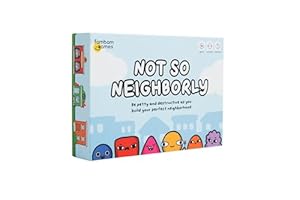Not So Neighborly is a 2-4 player party game that lets players live out the fantasy of terrorizing their neighbors over petty grievances—like putting the garbage bins too close to the driveway. The goal is simple: play cards to score 10 points while dodging dog poop, casual arson, and general pettiness. On each turn, a player either plays or draws a card, and then passes the turn to the next player.

The Cards and Gameplay
Scoring cards represent various neighborhood buildings, each worth 1-3 points. Along the way, players might draw mundane action cards, which allow them to skip an opponent’s turn, steal cards, or force discards. Then, there are the attack cards, the real chaos-makers. If you don’t enjoy “take-that” mechanics or prefer not to alienate your family before the next holiday gathering, I suggest you stop reading now and pick up Machi Koro instead. It’s likely to provide a far more enjoyable experience.
Attack cards are instant turmoil, designed to raze a neighbor’s carefully built plans. Imagine: just as a player envisions a serene neighborhood, they smell smoke—because their house is on fire. Or perhaps they wake up to find someone (or something) has left an unpleasant surprise on their porch, negating the ongoing power of a card. Worse, they might stand on their lawn, coffee in hand, watching their house get demolished before their eyes. While there are a few cards, like Neighborhood Watch, that can protect buildings from attacks, they only work against specific threats. For example, Neighborhood Watch can stop poop attacks but won’t help against arson. Useless!
This cycle of suburban chaos continues until one player manages to scrape together 10 points. Victory often comes not from strategy but from slipping under the radar while others gang up on a common enemy. A well-hidden 3-point School card can make all the difference.

The Verdict
Not So Neighborly is, unfortunately, not so fun. When it was pitched to me at Gen Con as a fast, light, and highly interactive town-builder, I was intrigued. But the gameplay fell short. Players are expected to punch and be punched to survive suburbia, but the interaction feels shallow and unengaging. The game is overly tactical, with success largely dictated by the luck of the draw.
In one game, I didn’t draw a single defense card, leaving my town in ruins for most of the session. Meanwhile, some players hardly drew attack cards, allowing one opponent to easily pull ahead. It wasn’t for lack of trying—we all wanted to be terrible neighbors—but the deck didn’t cooperate. Even when I used attack cards, it felt more obligatory than satisfying. The joy of sabotaging opponents seemed to have moved to the next neighborhood over.
I won one game, but my excitement didn’t come from winning—it came from the game being over. Despite its short 10-15 minute playtime, it felt like eating empty calories. The cards disrupt gameplay more than they enhance it. We even played two rounds at a bar before a wedding, dressed to the nines, and were quick to ditch the game afterward.
For a group of players who love competitive, cutthroat games, Not So Neighborly was a disappointment. Its unbalanced cards and poor deck distribution make it feel half-baked. The only way to draw more cards is to sacrifice your entire turn for one card—and if it’s not what you need, tough luck. You’re stuck while everyone else pulls ahead. The lack of reliable defenses or alternative strategies makes the game feel frustratingly one-sided.
As a party game with a “take-that” mechanic, Not So Neighborly needs more time in the oven. A better card balance or additional defense cards might improve the experience. For now, it’s safe to say this game will not so likely stick around in my collection.
Bonus: There’s a single card in the game meant to evoke laughter, but when it finally appeared, no one even cracked a smile. Ironic, isn’t it?













